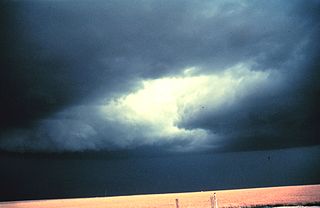
A tornado warning is an alert issued by national weather forecasting agencies to warn the public that severe thunderstorms with tornadoes are imminent or occurring. It can be issued after a tornado, funnel cloud and rotation in the clouds has been spotted by the public, storm chasers, emergency management or law enforcement.

A tornado watch is issued when weather conditions are favorable for the development of severe thunderstorms that are capable of producing tornadoes. A tornado watch therefore implies that it is also a severe thunderstorm watch. A tornado watch must not be confused with a tornado warning. In most cases, the potential exists for large hail and/or damaging winds in addition to tornadoes.

A severe thunderstorm warning is issued by the National Weather Service when trained storm spotters or Doppler weather radar indicate that a thunderstorm is producing or will soon produce dangerously large hail and high winds, capable of causing significant damage. Flooding caused by a thunderstorm's extreme rainfall. A similar warning is issued by Environment Canada's Meteorological Service of Canada from their offices in Vancouver, Edmonton, Toronto, Montreal and Dartmouth. Skywarn issues the severe thunderstorm warnings for the United Kingdom. In Australia, severe thunderstorm warnings are issued by the Bureau of Meteorology.

The National Weather Service (NWS) is an agency of the United States federal government that is tasked with providing weather forecasts, warnings of hazardous weather, and other weather-related products to organizations and the public for the purposes of protection, safety, and general information. It is a part of the National Oceanic and Atmospheric Administration (NOAA) branch of the Department of Commerce, and is headquartered in Silver Spring, Maryland, within the Washington metropolitan area. The agency was known as the United States Weather Bureau from 1890 until it adopted its current name in 1970.

NEXRAD or Nexrad is a network of 159 high-resolution S-band Doppler weather radars operated by the National Weather Service (NWS), an agency of the National Oceanic and Atmospheric Administration (NOAA) within the United States Department of Commerce, the Federal Aviation Administration (FAA) within the Department of Transportation, and the U.S. Air Force within the Department of Defense. Its technical name is WSR-88D.

The Storm Prediction Center (SPC) is a government agency that is part of the National Centers for Environmental Prediction (NCEP), operating under the control of the National Weather Service (NWS), which in turn is part of the National Oceanic and Atmospheric Administration (NOAA) of the United States Department of Commerce (DoC).

A hook echo is a pendant or hook-shaped weather radar signature as part of some supercell thunderstorms. It is found in the lower portions of a storm as air and precipitation flow into a mesocyclone resulting in a curved feature of reflectivity. The echo is produced by rain, hail, or even debris being wrapped around the supercell. It is one of the classic hallmarks of tornado-producing supercells. The National Weather Service may consider the presence of a hook echo coinciding with a tornado vortex signature as sufficient to justify issuing a tornado warning.
WeatherStar refers to the technology used by American cable and satellite television network The Weather Channel (TWC) to generate its local forecast segments on cable and IPTV systems nationwide. The hardware takes the form of a computerized unit installed at a cable system's headend. It receives, generates, and inserts local forecast and other weather information, including weather advisories and warnings, into TWC's national programming.
The National Severe Storms Laboratory (NSSL) is a National Oceanic and Atmospheric Administration (NOAA) weather research laboratory under the Office of Oceanic and Atmospheric Research. It is one of seven NOAA Research Laboratories (RLs).
This article describes severe weather terminology used by the National Weather Service (NWS) in the United States. The NWS, a government agency operating as an arm of the National Oceanic and Atmospheric Administration (NOAA) branch of the United States Department of Commerce (DoC), defines precise meanings for nearly all of its weather terms. This article describes NWS terminology and related weather scales used by the agency. Some terms may be specific to certain cities or regions.

KWTV-DT, virtual channel 9, is a CBS-affiliated television station licensed to Oklahoma City, Oklahoma, United States. It serves as the flagship television property of locally based owner Griffin Communications, and is part of a duopoly with MyNetworkTV affiliate KSBI. The two stations share studios on Kelley Avenue and 74th Street in northeast Oklahoma City, adjacent to the studios and main offices of the Oklahoma Educational Television Authority (OETA) PBS member network; KWTV's transmitter is located between 122nd Street and the John Kilpatrick Turnpike, also on the city's northeast side.
The Edmonton tornado of 1987, an event also known as Black Friday to Edmontonians, was a powerful and devastating tornado that ripped through the eastern parts of Edmonton, Alberta, Canada and parts of neighbouring Strathcona County on the afternoon of Friday, July 31, 1987. It was one of seven other tornadoes in central Alberta the same day.

Gary England is the former chief meteorologist for KWTV, the CBS-affiliated television station in Oklahoma City, Oklahoma. England was the first on-air meteorologist to alert his viewers of a possible tornado using a commercial Doppler weather radar. He is also known for contributing to the invention of the First Warning map graphic commonly used to show ongoing weather alerts without interrupting regular programming. Currently, Gary is the Vice President of Corporate Relations and Weather Development at Griffin Communications LLC, the parent company to KWTV-DT, although the company uses the same single-story building as the studio.
Volumetric Imaging and Processing of Integrated Radar, known by the acronym VIPIR, is an analysis and display program for Doppler weather radar, created and sold by Baron Services. This software allows improved analysis of radar data for private users, in particular television stations, similar to the Weather Decision Support System program used by the National Weather Service.
PMX refers to the technology developed by Pelmorex to generate local weather information on The Weather Network. PMX consists of computers, typically installed at a cable headend, that takes data fed to it and packages it for broadcast. Unlike the Weather Star systems, it does not generate full graphical or video segments, rather the information is super-imposed over the main video feed.
A significant weather advisory is issued when Doppler radar indicates a strong thunderstorm is producing small hail or high winds whose strength does not reach the criteria to be designated a severe thunderstorm. It does not necessarily account for lightning or flooding.
Michael Charles Carroll Morgan is an American television meteorologist. Since January 1993, he has served as a meteorologist for KFOR-TV, an NBC-affiliated television station in Oklahoma City, Oklahoma. Morgan – who, as its chief meteorologist, does weather segments for KFOR's 4:00, 4:30, 5:00, 6:00 and 10:00 p.m. newscasts each weeknight, in addition to helming the station's severe weather coverage – is a member of the American Meteorological Society (AMS) and the National Weather Association (NWA).

National Weather Service - Norman, Oklahoma is a Weather Forecast Office (WFO) of the National Weather Service based in Norman, Oklahoma, which is responsible for forecasts and the dissemination of weather warnings and advisories for central and most of western Oklahoma, and western portions of north Texas. It is located in the National Weather Center on the University of Oklahoma campus, where it acts as one of the NOAA Weather Partners, a group of close-together weather-related agencies of the National Oceanic and Atmospheric Administration. NWS Norman is currently overseen by David Andra, who serves as the Meteorologist In Charge of the office.
Leslie R. Lemon is an American meteorologist bridging research and forecasting with expertise in weather radar, particular regarding severe convective storms. Lemon is, along with Charles A. Doswell III, a seminal contributor to the modern conception of the supercell which was first identified by Keith Browning, and he developed the Lemon technique to estimate updraft strength and thunderstorm organization also as a continuation of Browning's work.

National Weather Service - Pleasant Hill/Kansas City, Missouri is a Weather Forecast Office (WFO) of the National Weather Service, which is responsible for forecasts and the dissemination of weather warnings and advisories for 37 counties in northern and western Missouri and seven counties in extreme eastern Kansas, including the Kansas City and St. Joseph metropolitan areas. Though, as the Storm Prediction Center (SPC) in Norman, Oklahoma is responsible for issuing severe thunderstorm and tornado watches, the Pleasant Hill/Kansas City WFO only composes outline and status updates for SPC-issued watches affecting any portion of its designated County Warning Area.








